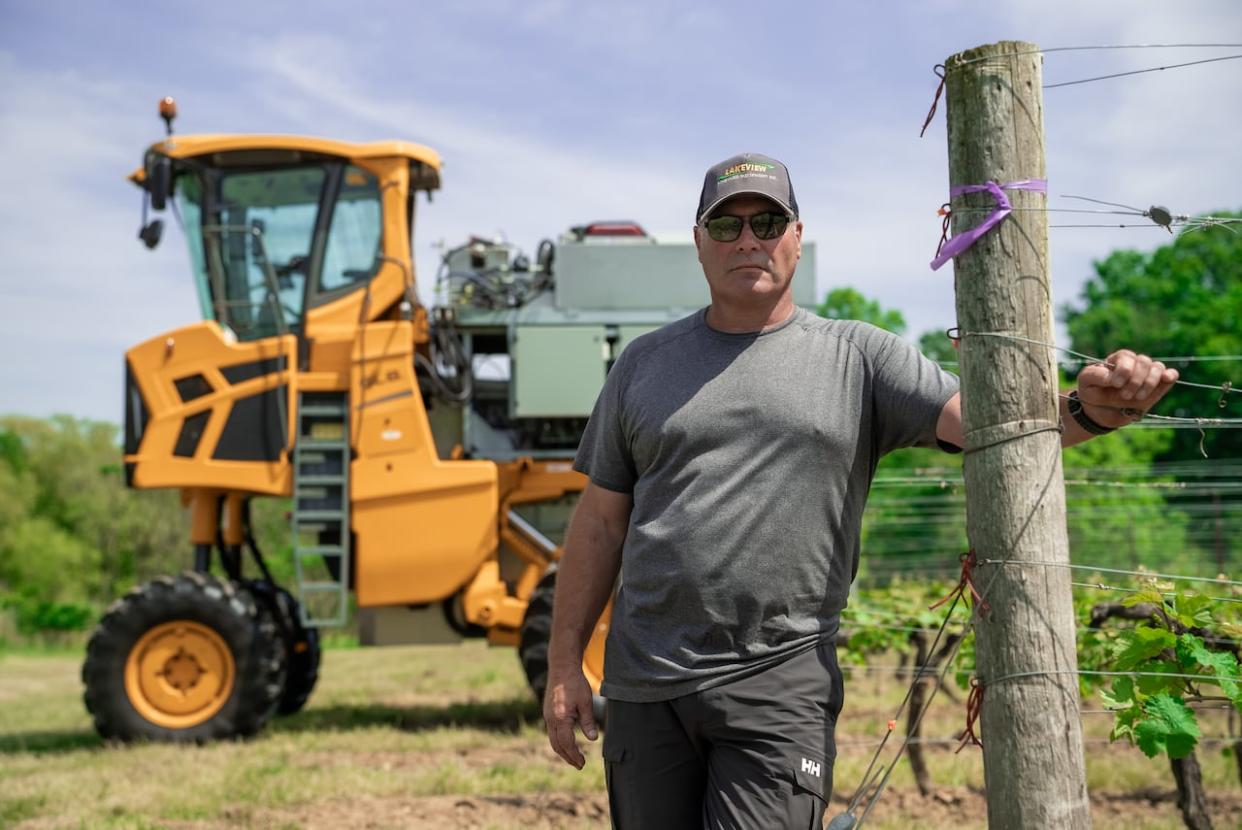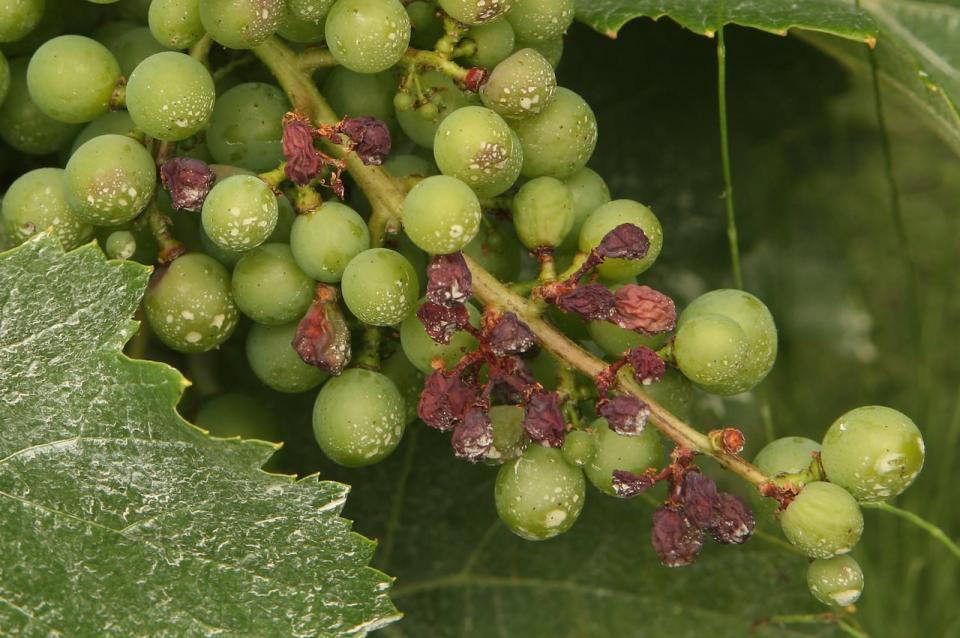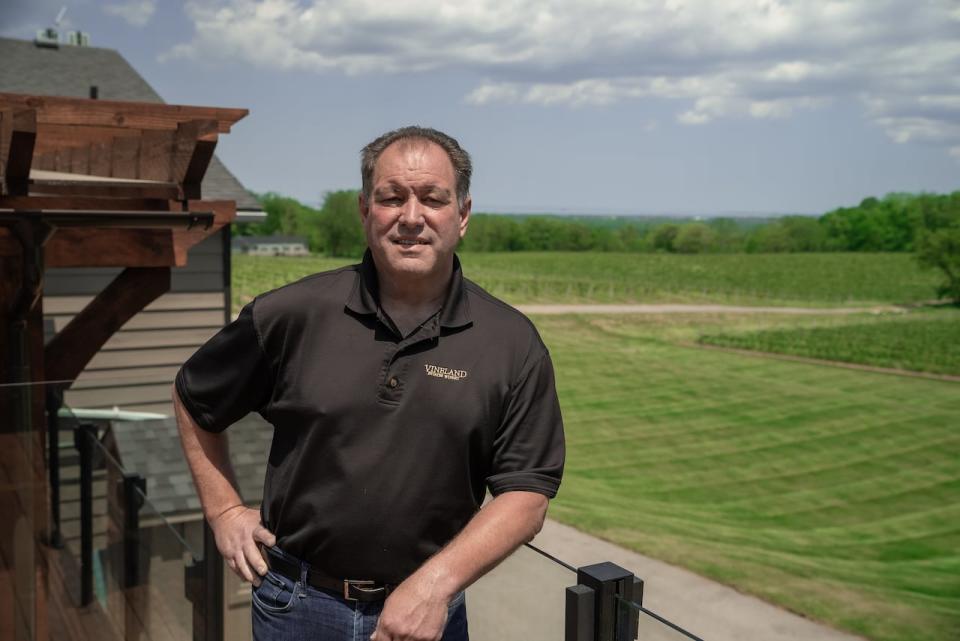Ontario winery testing new green Canadian technology to fight age-old threat to grape crop

Over the rumbling engine of a harvester, a high-pitched hiss emerges: hydrogen peroxide misting into the air. That mist is lit by the ethereal sky blue glow of ultraviolet lights, housed in giant panels that form a tunnel.
It all looks like it belongs in a biohazard facility.
But it's a new technological solution being tested at Vineland Estates Winery in Ontario's Niagara Region to deal with one of winemaking's oldest foes: powdery mildew.
"Powdery mildew can be disastrous. We can lose entire crops if not managed properly," said veteran winemaker Brian Schmidt. The starkly white mould affects the leaves and the berries, eventually coating them and destroying the fruit.
For a province that produced more than 75,000 tonnes of grapes last year, a bad year of mildew could see more than 5,000 tonnes of grapes wasted. And as the climate warms, experts warn that these fungal pathogens could get more opportunities to grow and spread.
Mildew has been a problem for winemakers for nearly 200 years. A fungus native to the United States, it ravaged through European grape crops in the 1850s before being controlled with sulphur and other methods.
WATCH | A new way for winemakers to fight grape fungus, without fungicides:
These days, it's managed with fungicides sprayed regularly throughout the growing season. The chemicals are expensive for wine growers, require strict safety protocols due to their toxicity and need to be managed carefully so fungi don't develop resistance to them.
The new system — developed and patented by St. Catharines, Ont., company Clean Works and being tested at Vineland Estates, which grows 40 hectares of grapes — attacks the fungus on the surface of the vine, unlike fungicides, which generally block the fungus from reproducing. The harvester moves over rows of vines and subjects them to three elements: hydrogen peroxide, ozone and UV-C light, which is a known disinfectant.
"That combination allows us to be able to rid ourselves of any pathogens in the vineyard, such as downy mildew, powdery mildew, black rot," Schmidt said, calling it a new tool in the winery's arsenal to manage these problems more sustainably.
More research needed to gauge impact
Experts say while this new approach could be effective, key questions remain about how it will affect the plant and deal with internal fungi.
"I think it has promise just because of the layering of those three strategies," said Megan Fisher, a lab instructor in the biology department at Mount Saint Vincent University in Halifax.
UV light, hydrogen peroxide and ozone are useful individually, she said, but together they create a very short-lived reaction that could have "an even more marked impact on microorganisms."
That reaction breaks down into oxygen and water, which means no chemicals are left behind.

Powdery mildew is shown on grapes at a vineyard in the wine-heavy Tarn region, near Gaillac, France. Experts say while the new system being used in Niagara Region could be effective, key questions remain about how it will affect the plant and deal with internal fungi. (Sean Gallup/Getty Images)
But Fisher warns that more research is needed to determine if prolonged exposure to this treatment will affect the genetics of the grape crop, which comes back every year from a woody stalk.
For Wayne Wilcox, professor emeritus at Cornell University in Ithaca, N.Y., who has been studying mildew and fruit diseases since the mid-1990s, the method seems "very effective in basically surface sterilizing. That's good in terms of yes, there's no residues, no chemical residues on the berries."
But Wilcox, who led the university's program in grape pathology, said these methods don't work as well when fungal pathogens strike deeper down.
"The spore germinates and it goes down into the berry or into the leaf and does its feeding down where it's protected from surface [treatments]," he told CBC News from the Finger Lakes region of upstate New York.
So far, Brian Schmidt said, a year of trials with the new system has shown that mildew was kept in check when compared with traditional fungicidal spraying — even with last year's particularly rainy season making conditions more favourable for fungi to thrive.
The system will continue to be tested on two hectares of vines, monitored and measured by scientists at the University of Guelph in southwestern Ontario.
Climate considerations
With Earth's climate warming, experts say fungi will have more opportunities to grow and expand their range. Although wine regions exist across climates, warmer air holds more moisture, which are two key environmental parameters for the spread of fungal pathogens.
"The more our climate shifts, the more likely we are to experience novel pathogens in our own growing environments," Mount Saint Vincent's Fisher said. "And so having ways to pivot and respond to that kind of threat is good."

Allan Schmidt, president of Vineland Estates, is shown at the Niagara Region winery, which grows 40 hectares of grapes. He and his brother plan to invite colleagues from other wineries to come and see the modified harvester in action this summer. (Turgut Yeter/CBC)
For Allan Schmidt, Brian's brother and president of Vineland Estates, the system helps reduce waste.
"If you got five million bottles of wine that are sitting, rotting on your fields, that's a big investment," he said, adding that the reduction of conventional sprays would also save the company tens of thousands of dollars a year.
Beyond that, the Schmidts see the new system as providing a legacy in sustainable winemaking. They plan to invite colleagues from other wineries to come and see the modified harvester in action this summer.
"We want to share it with the rest of Canada and ultimately the rest of the world in terms of sustainability," Allan Schmidt said.


